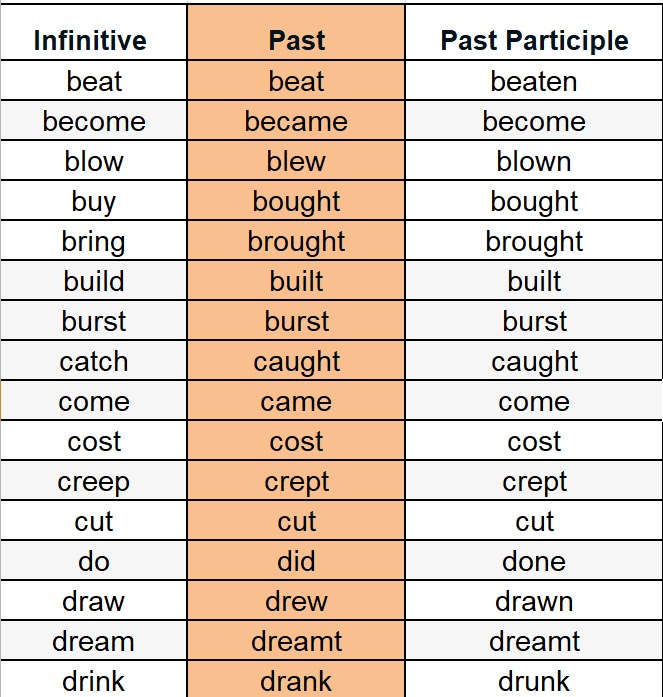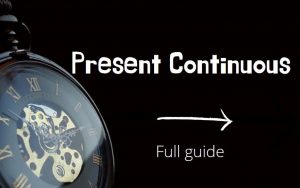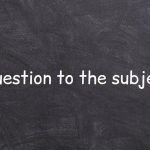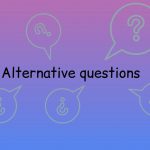The Past Simple is one of the most common tenses in the English language.
English learners usually learn the Past Simple right after the Present Simple. We can say the Past Simple is even simpler than the Present Simple.
If you learn the Past Simple, you will expand your potential to communicate in English. Because with the Past Simple you can talk about what already happened.
Think how important it is to be able to talk about what happened 10 years ago, a year ago, or just five minutes ago… This is what we use the Past Simple for.
We use the Past Simple to talk about what happened at a specific point in the past. It could be a minute ago or a thousand years ago. What happened and ended at a specific time in the past.
How to form sentences in Past Simple?
To form the Past Simple, we need to learn only two main rules:
- How to form the Past Simple with regular verbs.
- How to form the Past Simple with irregular verbs.
How to Form Past Simple using Regular Verbs
To form an affirmative (positive) sentence in the Past Simple with a regular verb, we add the -ed ending to the verb.
It doesn’t matter who is the subject in the sentence. We add the -ed ending to all regular verbs, regardless of the subject.
- I loved
- He loved
- She loved
- It loved
- They loved
- We loved
- You loved

How to add the -ed ending correctly
We add the -ed ending to regular verbs using these simple rules:
Rule 1: If the verb ends with the letter -e, we just add one letter -d. For example:
Love + d = Loved
She loved you.
Rule 2: If the verb ends with the letter -y, we change the letter -y to the letter -i and add the -ed ending. For example:
Сry (y->i) + ed = Cried
Babys cried.
Rule 3: If the verb ends in the letter -y, but there is a vowel before the letter -y, then we do not change anything, just add the -ed ending. For example:
Stay + ed = Stayed
He stayed here.
Rule 4: If the verb ends in a consonant preceded by a short vowel, we double the last consonant and then add the -ed ending. For example:
Travel (lx2) + ed = Travelled.
We travelled all around the world.
These rules may seem difficult, but as you practice, you will quickly learn these rules.
Now you know how to add the -ed ending to regular verbs. Regular verbs are very simple. But what about irregular verbs?
How to form Past Simple with irregular verbs
Not all verbs in English are regular. There is also a group of irregular verbs.
They are irregular because we cannot apply the same rules to them that we use with regular verbs.
You cannot simply add the -ed ending to irregular verbs. Let’s look at the verbs think and see.
Incorrect: Think – Thinked (this form does not exist).
Incorrect: See – Seed (this form does not exist).
Each of the irregular verbs has its own past tense form.
- Think – Thought
- See – Saw
- Run – Run
- Go – Went
As you can see, the past form of these verbs can even look exactly the same as the main form:
Run – Run
Or completely different than the main form looks:
Go – Went
If you want to use an irregular verb in the Past Simple, but you do not know what the past form of the verb is, you should look at this form in a table of irregular verbs.
Note: Each verb has 4 forms. In the Past Simple, we will only use the past form (the second form) of irregular verbs. Usually, in a table of irregular verbs, the past form (the second form) is in the second column.

How to form Affirmative (Positive) Sentences in Past Simple
To form an affirmative (positive) sentence in the Past Simple, we use the verb in its past form (with the -ed ending or the past form (the second form) if the verb is irregular). We put the verb after the subject.
Subject (I, We, She, John, Dad) + past form of main verb or second form of irregular verb (worked, loved, seen, thought) + rest of the sentence
I loved you.
I drank too much yesterday.
John went to school when he was a kid.
How to form Interrogative (Question) Sentences in Past Simple
To form an interrogative (question) sentence in the Past Simple, we don’t need to add any endings to the main verb!
In interrogative (question) sentences, we use regular and irregular verbs in the base form.
To form an interrogative (question) sentence, we need the past form of the auxiliary verb do. The past form of the verb do is did. It is did that shows that the action takes place in the past.
To form an interrogative (question) sentence, we put the auxiliary verb did at the beginning of the sentence. After that, we put the subject, then the main verb in the base form. After that, we can add the rest of the sentence if needed.
Did + Subject (I, We, She, John, Dad) + main verb in base form (love, watch, think, jump)
Examples:
Did you like to play football when you were a kid?
Did she talk to you about her secret?
Did John drive to work this morning?
Remember, in interrogative (question) sentences we use the auxiliary did regardless of who is the subject/persons.
- Did I love you?
- Did he love you?
- Did she lobe you?
- Did it love you?
- Did they love you?
- Did we love you?
- Did you love me?
How to form Special or Wh-Questions in the Past Simple
There is a type of question in English called Special or Wh-Questions.
These are the questions we ask for more information.
The difference between a regular Yes/No Question and a Special or Wh-Question is very simple:
John, did you drink coffee in the morning?
This is a Yes/No Question. The purpose of this question is to ask John if he drank coffee in the morning.
John, how many cups of coffee did you drink in the morning?
This is a Special or Wh-Question. We ask this question to find out exactly how many cups of coffee John drank in the morning.
John, how many cups of coffee did you drink in the morning?
In this question, we are interested in additional information (HOW MANY CUPS OF COFFEE). Therefore, we added the additional (question) words HOW MANY to this question.
Examples of most popular additional (question) words that we use to get additional information in interrogative (question) sentences:
- who
- how
- which
- why
- what
- when
- where
In Special or Wh-Questions, we can use not only an additional word but also a whole additional phrase:
When and where did you talk to Jessica yesterday?
We form Wh-Questions almost the same way as Yes/No Questions. In Wh-Questions, we simply put an additional word (or phrase) at the beginning of the sentence:
Question word (or phrase) + did + Subject (I, We, She, John, Dad) + main verb (love, watch, think, jump).
Examples:
Why did you like playing football?
Where did she talk to you about her secret?
What time did John drive to work this morning?
How to Answer Questions
We form a short affirmative (positive) answer in the Past Simple with the auxiliary did. Before did, we put the affirmative (positive) word yes.
Did John talk to you yesterday?
Yes he did.
It is important to understand that in the short answer did acts as the verb that was in the question:
Did you call him in the morning?
Yes, I did.
In this example, Did means “call”. Therefore, in this sentence, the answer means “Yes, I called.” We used did instead of the verb called to shorten the answer.
A negative short answer is formed in the same way, only we add the particle not to did. At the beginning of the sentence, we put the word no:
Did you call him in the morning?
No, I did not.
Now take a look at how we form a full affirmative (positive) answer.
We put “Yes” or “No” at the beginning of the full answer. After that, we repeat the sentence from the question in an affirmative (positive) or negative form of the Past Simple. If the answer is negative we also add did not:
Did you call him this morning?
Yes, I called him this morning.Did you call him this morning?
No, I didn’t call him this morning.
How to form Negative Sentences in Past Simple
We form negative sentences in the Past Simple using the auxiliary did and the negative not.
did + not = did not
We use did not regardless of who is the subject.
We do not change the main verb in a negative sentence. We do not add any endings to the main verb. We do not use the past form (the second form) for irregular verbs. We use the main verb in its base form (love, jump, play).
We form negative sentences using this formula:
Subject (I, He, She, Mom, John, Dog ) + did not + main verb in its base form + rest of the sentence (if needed).
She did not go to school today.
I did not like sports when I was a child.
John did not drink coffee in the morning.
What is the abbreviation (short form) for did not?
We rarely use the full form did not. We use the full form in formal speech or certain expressions. In spoken English and informal writing, we most often use the short form didn’t.
| Full | Short |
|---|---|
| I did not | I didn’t |
| He did not | He didn’t |
| She did not | She didn’t |
| It did not | It didn’t |
| We did not | We didn’t |
| They did not | They didn’t |
| You did not | You didn’t |
I didn’t drink coffee this morning.
The children didn’t go to school.
John didn’t see Jessica yesterday.
To be in Past Simple
We form affirmative, negative, and question sentences with the verb to be in the Past Simple according to special rules. These rules are different from the rules we use with other, regular verbs.
To use the verb to be in Past Simple, there are two important things to remember:
First: We do not use any auxiliary verbs with the verb to be in the Past Simple. To be forms affirmative, question, and negative sentences on its own. We do not use the verb did/did not.
Second: In the past simple, the verb to be has only two forms:
- was
- was

If the subject is a noun or pronoun in the first-person singular (I, he, she, it), we use was:
- I was
- He was
- She was
- It was
If the subject is a plural noun or pronoun (we, they), we use were:
- We were
- They were
We use were with the pronoun you. It doesn’t matter if the subject (you) is one person or many:
- You were.
To form a Positive sentence, we put the verb to be after the subject.
John was so happy to see you.
We were obviously a lot closer than l realized.
To form a question (interrogative) sentence, we put the verb to be before the subject.
Was he here the morning that he got shot?
Were we as cynical at that age?
In a negative sentence, we add the negative not.
He was not the man I thought he was.
We were not allowed to sleep for a long time.
You can also read the main article To Be in Past Simple.
How to Use To Have in Past Simple?
to have is another special verb. You must learn how to use to have correctly in the Past Simple.
to have in the Past Simple uses its own form. Also to have forms Positive, Question, and Negative sentences according to its own special rules.
Why do we use to have?
We use to have to show / to say that someone or something had something, that someone/something owned, possessed someone or something.
We had a big family.
I had a good job five years ago.
How to form sentences with to have in the Past
The verb to have in the past is very easy to form! Because to have has only one form for all persons – had.
It doesn’t matter who plays the part of the subject in the sentence, because the form of the verb to have in the Past Simple always looks like had regardless of the subject.
- I had
- He had
- She had
- It had
- We had
- They had
- You had
I had good friends at school.
We had the best team in town.
They had a lot of money ten years ago.
How to form Affirmative (Positive) Sentences with to have
To form a Positive sentence, we put had after the subject.
We had a big family.
Five years ago I had a good job.
How to form Interrogative (Question) Sentences with to have
To form an interrogative (question) sentence, we use the same rules as for ordinary verbs in the Past Simple. It means that we use the auxiliary did. We use the verb to have in its base form – have (without to).
Why do we use have instead of had? Because in questions we use the auxiliary verb did, which indicates that this is the past. Therefore, we do not need to use the past form of the verb to have – had.
We put did first before the subject. Then we put the subject. After the subject, we put the verb have.
Did you have many friends at school?
Did they have a good team last season?
Did she have any problems because of me?
How to form Negative Sentences with to have
We form negative sentences with to have, just like we do with regular verbs in the Past Simple.
We need the auxiliary did and the negative not: did not.
First, we put the subject, then did not. Did not is followed by have (without to).
You did not have many friends before.
They did not have any problems after what they did.
Please note that in negative sentences the verb to have remains in the form have, and does not change to the past form had. We show that this is the past tense using the auxiliary verb did.
Incorrect: You did not had many friends before.
Incorrect: They did not had any problems.
When we Use the Past Simple
Let’s take a look at the most popular use cases for the Past Simple. The Past Simple is used:
- We use the Past Simple when we talk about facts that happened in the past.
Julius Caesar invaded Britain in 55 BC.

- We use the Past Simple to describe a simple action that happened in the past.
He understood you.
Jessica said a lot of unpleasant things.
- We use the Past Simple to answer a question when we can answer by saying the exact date.
She met him 10 years ago.
We visited John last weekend.
- To describe the state of someone or something in the past.
They were the best players on our team.
It was a big setback!
There was a house on this place.
- To describe regular, repetitive actions in the past.
John and Jessica went to the theater every weekend.
- To describe sequential actions in the past.
The dog went into the yard, saw a big cat, and ran after the cat.
I came to work, phoned the client, and made an appointment.
- We use the Past Simple to describe a story.
The car collided with another car. The two drivers were fine. But their cars were crashed badly.
- When someone asks a question about when something happened or happened.
When did the first world war start?
When did he buy the car?
When did John and Jessica break up?
- To describe actions that happened in the past and can no longer happen again.
My parents met at a party.
The first day at the new school was a disaster!
- To describe actions that happened in the past and ended in the past.
It doesn’t matter how long actions lasted or how many times actions happened. The important thing is that these actions can no longer happen and these actions have no relation to the present.
My dad flew into space!
Elvis Presley played the guitar well.
This team became the champion five times in a row!
- We use the Past Simple to describe the details of some kind of news or event.
Note: We often use the Present Perfect to tell the very fact that a piece of news or story has happened. After that, we usually use the Past Simple to tell about the details of what happened.
I have bought a new phone! I went to the store to buy a TV, but I saw this phone and decided to buy it instead of a TV.
Scientists have discovered an unusual fish. They caught her and put her in a special aquarium.
The team won the championship! In the last game, the team scored three goals and won.
You can also read the full article Present Perfect and Past Simple: Difference
Time Clauses
We use the Past Simple in Past Time Clauses after such words as:
- when
- until
- as soon as
- before
- after
When she called me, I was watching TV.
After the game ended, the players were very happy.
As soon as I bought the car I met your mom.
Second Conditional
The Second Conditional is a conditional sentence in which we mean an unrealistic condition and result. The condition is almost unrealistic. The probability that what is described in the condition will happen is very small.
The Second Conditional formula looks like this:
If + the Past Simple (condition), would + the base form of the main verb (result)
If I had talent, I would have been hired on the team.
If Dad made more money, we would buy a big house.
If I had a dog, I would be very happy.
NOTE: If in the part with IF the main verb is the verb to be, then we do not change be to was in the third-person singular. This means that you must use were regardless of who is the subject (with all persons).
Correct: If I were you, I would tell her the whole truth.
Incorrect: If I was you, I would tell her the whole truth.
Correct: If he were rich, he would have gone to live in another country.
Incorrect: If he was rich, he would have gone to live in another country.

Past Simple and I wish
We use the Past Simple with one interesting and important construction in English. This is I wish.
I wish is the phrase we use to say that we regret something that didn’t happen before. Or we regret something that doesn’t happen the way we want it to.
Such a sentence always begins with the words I wish, followed by a subordinate clause.
If we mean the future or present in the subordinate clause, we use the Past Simple.
I wish you didn’t leave …
I wish I were rich …
Sometimes we put the Conjunction that after I wish, but often we don’t use it.
I wish I had a good job …
I wish that I had a good job …
If we use to be in a sentence with I wish, then we use were (not was) regardless of who is the subject. Even in the third-person singular.
Incorrect: I wish I was rich …
Correct: I wish I were rich …
ATTENTION: In spoken English and informal writing, you can hear a sentence with I wish and was.
I wish he was rich …
In spoken English and informal writing, we can use was. But in formal speaking and writing, you should use were.
Past Simple and It is time
It is time is another interesting phrase we often use in the Past Simple. By using this phrase, we can say that at the moment of speaking is the right time for someone to do something.
It is time we went home!
It is time you learned this.
It is time you had some proper training.
It is time the children learned a little respect.
Maybe it’s time you did something!
Please note that we use the Past Simple, even though this action refers to the present or even future.
Now look at another example which is formed with two sentences:
It’s time you did your homework. It’s getting dark soon.
Notice in the second sentence we used the Present Simple to indicate the “reason”. We use the Past Simple only in the sentence that contains the phrase It is time.
It’s time you did your homework. It’s getting dark soon.
Markers of Past Simple
Markers are special words that help us understand the timing of a sentence.
The Past Simple has its own markers that indicate that the action took place in the past.
The most popular markers we use in the Past Simple are:
- an hour ago
- two hours ago
- one week ago
- in 1965
- last year
- three days ago
- on Friday
- yesterday
- the day before yesterday
- just now
- the other day
- at 8 o’clock
- when I was a kid
- last year
- last decade
- last century
- last week
- last month
Examples of sentences with markers:
I met John last year.
I saw this cat in this room five seconds ago!
He told her the whole truth last week.
We were friends when we were in school.
John met Jessica 6 years ago.
Mom was at work on Friday.
The school closed last year.
Our team won their most important game three days ago.

The Past Simple is not difficult to learn. But along with the Present Simple, the Past Simple will expand your ability to speak and understand English.










